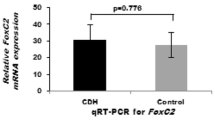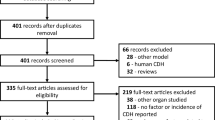Abstract
Purpose
Nitrofen model of congenital diaphragmatic hernia (CDH) has been widely used to investigate the pathogenesis of pulmonary hypoplasia (PH). Fibroblast growth factor (FGF) signaling pathway plays a fundamental role in fetal lung development. FGF7 and FGF10, which are critical for lung morphogenesis, have been reported to be downregulated in nitrofen-induced PH. FGF signaling is mediated by a family of four single transmembrane receptors, FGFR1–4. FGFR2 and FGFR3 have been shown to be expressed predominantly in the late stages of developing lungs. In addition, the upregulation of FGFR2 gene expression has been associated with severe defects in lung development and resulted in arrested alveologenesis similar to PH seen in the nitrofen model. Furthermore, FGFR3−/−FGFR4−/− double mutants showed thinner mesenchyme and larger air spaces. We designed this study to test the hypothesis that FGFR gene expression is upregulated in the late stages of lung development in the nitrofen CDH model.
Methods
Pregnant rats were exposed to either olive oil or nitrofen on day 9 of gestation (D9). Cesarean section was performed and fetuses were harvested on D18 and D21. Fetal lungs were divided into three groups: control, nitrofen without CDH [CDH(−)], and nitrofen with CDH [CDH(+)] (n = 24 at each time-point). Pulmonary gene expression levels of FGFR1–4 were analyzed by real-time RT-PCR. Immunohistochemistry was also performed to evaluate protein expression/distribution at each time-point.
Results
The relative messenger RNA expression levels of pulmonary FGFR2 and FGFR3 on D21 were significantly increased in CDH(−) (6.38 ± 1.93 and 7.84 ± 2.86, respectively) and CDH(+) (7.09 ± 2.50 and 7.25 ± 3.43, respectively) compared to controls (P < 0.05 and P < 0.01, respectively), whereas no significant alteration was observed on D18. There were no differences in FGFR1 and FGFR4 expression at both time-points. Increased immunoreactivity of FGFR2 and FGFR3, mainly in the distal epithelium and mesenchyme, was observed in the nitrofen-induced hypoplastic lungs on D21 compared to controls.
Conclusion
Upregulation of FGFR2 and FGFR3 pulmonary gene expression in the late stages of fetal lung development may disrupt FGFR-mediated alveologenesis resulting in PH in the CDH model.

Similar content being viewed by others
References
Bohn D (2002) Congenital diaphragmatic hernia. Am J Respir Crit Care Med 166(7):911–915
Stege G, Fenton A, Jaffray B (2003) Nihilism in the 1990s: the true mortality of congenital diaphragmatic hernia. Pediatrics 112(3 Pt 1):532–535
Gosche JR, Islam S, Boulanger SC (2005) Congenital diaphragmatic hernia: searching for answers. Am J Surg 190(2):324–332
Sabharwal AJ, Davis CF, Howatson AG (2000) Post-mortem findings in fetal and neonatal congenital diaphragmatic hernia. Eur J Pediatr Surg 10(2):96–99
Noble BR, Babiuk RP, Clugston RD et al (2007) Mechanisms of action of the congenital diaphragmatic hernia-inducing teratogen nitrofen. Am J Physiol Lung Cell Mol Physiol 293(4):1079–1087
Montedonico S, Nakazawa N, Puri P (2008) Congenital diaphragmatic hernia and retinoids: searching for an etiology. Pediatr Surg Int 24(7):755–761
Lebeche D, Malpel S, Cardoso WV (1999) Fibroblast growth factor interactions in the developing lung. Mech Dev 86(1–2):125–136
Warburton D, Schwarz M, Tefft D et al (2000) The molecular basis of lung morphogenesis. Mech Dev 92(1):55–81
Dionne CA, Crumley G, Bellot F et al (1990) Cloning and expression of two distinct high-affinity receptors cross-reacting with acidic and basic fibroblast growth factors. EMBO J 9(9):2685–2692
Keegan K, Johnson DE, Williams LT et al (1991) Isolation of an additional member of the fibroblast growth factor receptor family, FGFR-3. Proc Natl Acad Sci USA 88(4):1095–1099
Partanen J, Makela TP, Eerola E et al (1991) FGFR-4, a novel acidic fibroblast growth factor receptor with a distinct expression pattern. EMBO J 10(6):1347–1354
Thisse B, Thisse C (2005) Functions and regulations of fibroblast growth factor signaling during embryonic development. Dev Biol 287(2):390–402
Lin X, Buff EM, Perrimon N et al (1999) Heparan sulfate proteoglycans are essential for FGF receptor signaling during Drosophila embryonic development. Development 126(17):3715–3723
Metzger RJ, Krasnow MA (1999) Genetic control of branching morphogenesis. Science 284(5420):1635–1639
Teramoto H, Yoneda A, Puri P (2003) Gene expression of fibroblast growth factors 10 and 7 is downregulated in the lung of nitrofen-induced diaphragmatic hernia in rats. J Pediatr Surg 38(7):1021–1024
Powell PP, Wang CC, Horinouchi H et al (1998) Differential expression of fibroblast growth factor receptors 1 to 4 and ligand genes in late fetal and early postnatal rat lung. Am J Respir Cell Mol Biol 19(4):563–572
De Langhe SP, Carraro G, Warburton D et al (2006) Levels of mesenchymal FGFR2 signaling modulate smooth muscle progenitor cell commitment in the lung. Dev Biol 299(1):52–62
Weinstein M, Xu X, Ohyama K et al (1998) FGFR-3 and FGFR-4 function cooperatively to direct alveogenesis in the murine lung. Development 125(18):3615–3623
Cardoso WV (2001) Molecular regulation of lung development. Annu Rev Physiol 63:471–494
Sekine K, Ohuchi H, Fujiwara M et al (1999) Fgf10 is essential for limb and lung formation. Nat Genet 21(1):138–141
Ornitz DM, Xu J, Colvin JS et al (1996) Receptor specificity of the fibroblast growth factor family. J Biol Chem 271(25):15292–15297
Han RN, Liu J, Tanswell AK et al (1992) Expression of basic fibroblast growth factor and receptor: immunolocalization studies in developing rat fetal lung. Pediatr Res 31(5):435–440
Moura RS, Coutinho-Borges JP, Pacheco AP et al (2011) FGF signaling pathway in the developing chick lung: expression and inhibition studies. PLoS One 6(3):17660
Peters KG, Werner S, Chen G et al (1992) Two FGF receptor genes are differentially expressed in epithelial and mesenchymal tissues during limb formation and organogenesis in the mouse. Development 114(1):233–243
Cool SM, Sayer RE, van Heumen WR et al (2002) Temporal and spatial expression of fibroblast growth factor receptor 4 isoforms in murine tissues. Histochem J 34(6–7):291–297
Author information
Authors and Affiliations
Corresponding author
Rights and permissions
About this article
Cite this article
Friedmacher, F., Doi, T., Gosemann, JH. et al. Upregulation of fibroblast growth factor receptor 2 and 3 in the late stages of fetal lung development in the nitrofen rat model. Pediatr Surg Int 28, 195–199 (2012). https://doi.org/10.1007/s00383-011-2985-2
Published:
Issue Date:
DOI: https://doi.org/10.1007/s00383-011-2985-2




